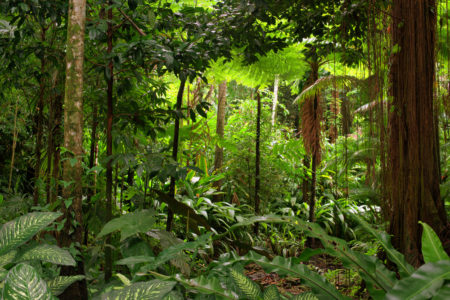June 11, 2019 – Please welcome Anna Kucirkova and her first guest contribution to 21st Century Tech Blog. Anna has been a copywriter for more than four years. She speaks three languages, loves to travel and write, and has a passion for kids. She has traveled to many places in Europe and Southeast Asia and is still exploring. In this post, she describes the importance of rainforests to the planet, and that in their peril, life as we know it is imperiled as well. As always your questions and comments are welcomed.
Most experts say that over 32,000 hectares (80,000 plus acres) of rainforest is being destroyed daily, with an additional 32,000 hectares being significantly damaged from logging, agriculture, farming, mining, and dam building. Commercial deforestation is occurring on a staggering global scale, and scientists estimate that we are losing 50,000 species of plants and animals annually to extinction from deforestation.
A few specific industries are causing widespread upticks in deforestation which the United Nations’ Food and Agriculture Organization notes is 8.5% higher in this decade than in the 1990s. Further, researchers estimate that the loss of primary tropical rainforest, which is the wildest and most biologically diverse has increased by as much as 25% since the 1990s.
As many nations in the Developing World grow their economies at rapid rates, the appetite for raw materials and land to farm and develop threatens rainforests around the globe. There are, however, plenty of ways to save rainforests, the biodiversity dependant upon them, and much of the world’s freshwater sources.
The Rainforest Makes it Rain
Rainforest decline creates “negative feedback loops.” What do we mean by this term? The same trees that absorb carbon dioxide (CO2) and regulate water vapour in the air, release the greenhouse gas when chopped down, and no longer filter the air. The Amazon rainforest’s massive network of trees is an example of a feedback loop. In recent issues of National Geographic, it explains the amazing interaction of the world’s rainforests with climate and how these tropical oases create a “giant flowing river in the sky.” It is this atmospheric river that delivers rain to places as far away as India. Cut down the trees and you turn the Amazon Basin into an arid wasteland arid further disrupt global weather patterns thousands of kilometers away. We can already see what current deforestation of the Amazon is doing as it impacts areas of the planet causing water shortages. The more we cut the higher degree of likelihood that we will be adding to the growing freshwater crisis across the planet. Most impacted will be Developing Nations located in tropical regions where rainforests are predominant. Here with countries seeing population booms, the harvesting of wood and clearing of land for agricultural use is seen as an economic necessity but it comes with a steep environmental price.
Food-Hungry Nations Are Driving Deforestation
Much of the deforestation happening today is because of rising food demand in the fastest growing population areas of our planet. Africa, South Asia, and South America are the areas where economic demands are clashing with rainforest conservation.
For example, in West Africa, the cocoa trade has spurred massive deforestation in Ivory Coast, with rainforest cover reduced by more than 80% in the last sixty years. Global demand for cocoa has created a rampant black and grey market for the beans and caused enforcement agencies in countries like Ghana and Ivory Coast to turn a blind eye to illegal practices accounting for up to 40% of trade in the global supply chain. Because it is difficult to discern the provenance of cocoa once gathered in bulk for processing, industry giants like Nestle and Hershey are fueling demand for illegal cocoa which is farmed primarily in freshly-deforested areas where local farmers believe the “fresh” soil and ashes from burned trees produces the highest crop yields. Deforested areas, however, see soil fertility diminish rapidly, and also experience drops in precipitation without the natural regulation that the rainforest brings. As these cleared forest areas lose their productivity, the inclination of those exploiting the land is to move on and burn more of the forest contributing even more to unintended consequences.
Another example is the growing of palm oil in tropical rainforest regions. Palm oil is a common vegetable oil used in foods, cosmetics, cleaning products, and fuels. It is a biological equivalent to petroleum and its harvesting is often similarly destructive to fossil fuel production. It is grown in deforested sections of Sumatra where you can find palm oil plantations that are creating a major ecological crisis for the biodiversity of the island including negative impacts on populations of elephants, tigers, rhinos, and orangutans.
Palm oil is cheap and easy to produce. It can be found in half of all consumer products on the market today. But although it represents an inexpensive vegetable oil source, its environmental costs make it today, one of the most costly commonly-used ingredients we consume globally. And if you look at the ingredients of consumer goods that you buy and use daily, the name palm oil is often not mentioned, replaced with terms like vegetable oil, sodium lauryl sulfate, stearic acid, and palmitate.
Much like the cocoa industry, palm oil is aggregated at processing plants which effectively obscure the oil’s origin, thus “absolving” buyers of direct responsibility for illegal deforestation. The demand for these two rainforest-grown resources comes from international companies acutely aware of the practices required to create supply. But, to a large extent, companies like Procter & Gamble continue to use illegal planting-sourced palm oil in products.
Today, Sumatra’s deforestation rate is among the world’s highest closely followed by Indonesia and Brazil. In Indonesian Sumatra and Malaysia, the equivalent of 300 football fields per hour of rainforest is being turned into palm oil plantations. The deforestation is contributing to drought and the proliferation of wildfires which in 2015 alone, created more CO2 emissions than all of the United Kingdom. Logging-induced fires that year destroyed over 20,000 square kilometers (8,000 square miles) of rainforest and contributed to more than 100,000 premature deaths from exposure to smog or fire.
The deforestation in Indonesia, Malaysia, and Brazil has largely happened in the absence of government enforcement of environmental laws. These nations seem reluctant to enforce rainforest sustainability practices. As a result, Borneo has seen more than 41,000 square kilometers (16,000 square miles) of its ancient rainforests replaced by palm oil plantations with the resultant catastrophic loss of biodiversity. To put this in a one species context, one closely related to humans, it means almost 150,000 critically endangered Bornean orangutans have been killed between 1999 and 2015 because of deforestation for the purposes of fulfilling palm oil demand.
Local Solutions to Global Problems
The unfortunate reality is that concerned environmentalists have little to no direct impact or power over local governments which theoretically are put in place to protect their rainforests. Consumers, corporations, and environmental organizations, however, can make a difference through education initiatives and through products they purchase looking for alternatives to those that are environmentally harmful are produced unsustainably.
Whether it’s public information campaigns that share the destructive backstory of palm oil with consumers in an effort to pressure major manufacturers or it’s small technology companies and nonprofits offering tools to help local enforcement agencies monitor and protect the forests under their jurisdiction, there are ways we can protect the fragile ecosystems of the world, even if we do not have direct voting power in the nations in which they are located.
The Rainforest Connection is using machine-learning and second-hand smartphones to create a network of “eyes and ears” in the Amazon to listen for noises associated with (illegal) logging activity as well as animal chatter that indicates the presence of certain critically-endangered and internationally-protected species. This project addresses a number of problems associated with protecting rainforests which when standing are extremely dense and difficult to navigate through and monitor. The project also gives international watchdog groups credible evidence of threats to endangered species from logging activity in specific areas, a far more actionable data point than the most thorough and credible research hypotheses.
Final Thoughts
Deforestation in global rainforests effects all of us, no matter where we live. The good news is that we collectively can directly protect the rainforests by reducing demand for those products contributing to deforestation, all while providing major corporations economic incentive to be transparent and supportive of ecological and forest sustainability initiatives instead of turning a blind eye to the ecological damage being wrought upon this important global natural resource.
The original article with edits is republished here with the permission of the author. You can visit the original text here.
















